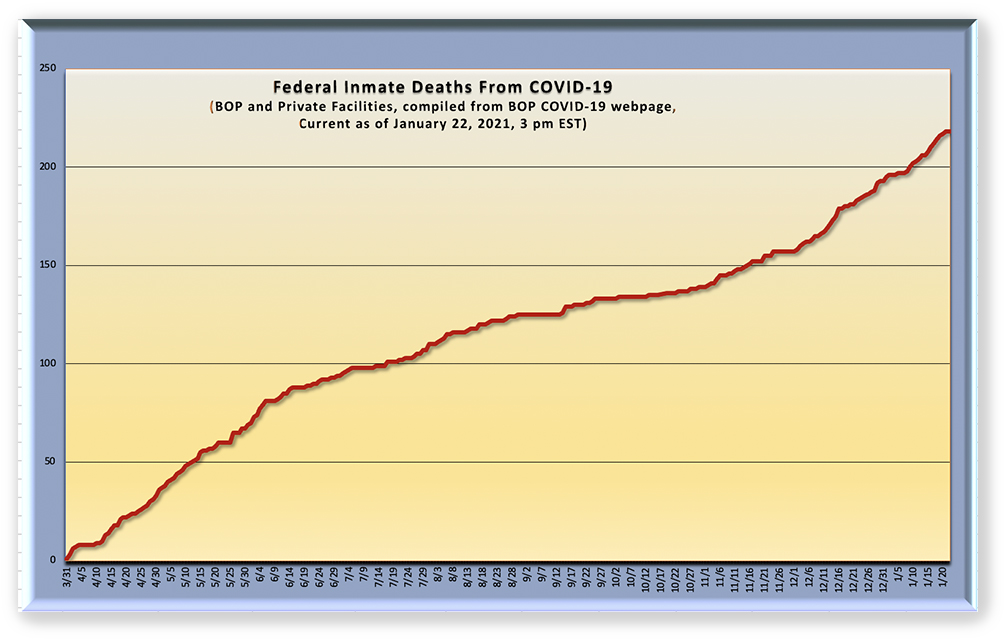We post news and comment on federal criminal justice issues, focused primarily on trial and post-conviction matters, legislative initiatives, and sentencing issues.

COVID NUMBERS ARE DOWN, BUT ARE THEY RELIABLE?
COVID numbers are down 26% from a week ago, with 3,738 federal inmates in BOP and private prisons sick. The BOP staff numbers remain stubbornly high at 2,005, down only 1% from last week. Deaths are spiking, with 12 more between Jan 15 and last Friday, for a total of 220. The BOP has tested two-thirds of its inmates, with an overall positivity rate of 44%.
 The BOP continues to report that large numbers of inmates are “recovered” according to Centers for Disease Control and Prevention Guidelines, despite the fact that the number of “recovered” inmates who subsequently die of COVID keeps increasing. On Thursday, the BOP reported that Shauntae Hill, an FCI Terre Haute inmate whom it had declared “recovered” last September, tested positive for COVID December 12 – 79 days later – and died two weeks ago. Last Friday, the BOP reported that Spencer Sarver, a USP Atlanta inmate who tested positive for COVID last March – but was declared “recovered” on April 23 – never left the hospital, and died ten days ago.
The BOP continues to report that large numbers of inmates are “recovered” according to Centers for Disease Control and Prevention Guidelines, despite the fact that the number of “recovered” inmates who subsequently die of COVID keeps increasing. On Thursday, the BOP reported that Shauntae Hill, an FCI Terre Haute inmate whom it had declared “recovered” last September, tested positive for COVID December 12 – 79 days later – and died two weeks ago. Last Friday, the BOP reported that Spencer Sarver, a USP Atlanta inmate who tested positive for COVID last March – but was declared “recovered” on April 23 – never left the hospital, and died ten days ago.
 The CDC Guidelines say that “available data indicate that persons with mild to moderate COVID-19 remain infectious no longer than 10 days after symptom onset. Persons with more severe to critical illness or severe immunocompromise likely remain infectious no longer than 20 days after symptom onset.” But nowhere does the CDC say recovered people are cured, but rather only that any virus they are shedding is at a concentration at which “infectiousness is unlikely.”
The CDC Guidelines say that “available data indicate that persons with mild to moderate COVID-19 remain infectious no longer than 10 days after symptom onset. Persons with more severe to critical illness or severe immunocompromise likely remain infectious no longer than 20 days after symptom onset.” But nowhere does the CDC say recovered people are cured, but rather only that any virus they are shedding is at a concentration at which “infectiousness is unlikely.”
James Weldon, president of the union local representing BOP employees at FCI Raybrook, last week accused the BOP of not reporting inmate and staff COVID cases after it brought in around 100 new inmates without testing them first. Weldon said the BOP never reported on the 130 inmates and 25 staff who tested positive during the peak of the outbreak two weeks ago.
The BOP reportedly failed to response to the newspaper with a comment.
 The Denver Gazette reported last week that out of two dozen responses to compassionate release motions based on COVID-19 from September through December, federal judges in Colorado only approved three. Besides finding that an inmate’s health condition or COVID at the particular facility was not severe, judges commonly denied requests to those who were not over 65 or had not served at least 75% of their sentences.
The Denver Gazette reported last week that out of two dozen responses to compassionate release motions based on COVID-19 from September through December, federal judges in Colorado only approved three. Besides finding that an inmate’s health condition or COVID at the particular facility was not severe, judges commonly denied requests to those who were not over 65 or had not served at least 75% of their sentences.
In two denials filed by Senior Judge Marcia S. Krieger, she found inmates may be safer from COVID-19 in prison than outside of it, despite the fact that the BZOP infection rate is five times that in the general population. “Release from custody would not ensure that he would not contract COVID-19,” Krieger wrote in one case. “Indeed, his release into the community – to socialize, to work, to shop, etc. – could increase, rather than decrease his risk of contracting the disease.”
BOP, Inmate Death at FCI Terre Haute (January 21, 2021)
BOP, Inmate Death at USP Atlanta (January 22, 2021)
CDC, Duration of Isolation and Precautions for Adults with COVID-19 (October 19, 2020)
Adirondack Daily Enterprise, Union: Prison apathetic about COVID (January 19, 2021)
Denver Gazette, Federal judges in Colorado denied overwhelming majority of requests to release inmates for COVID-19 (January 20, 2021)
– Thomas L. Root





